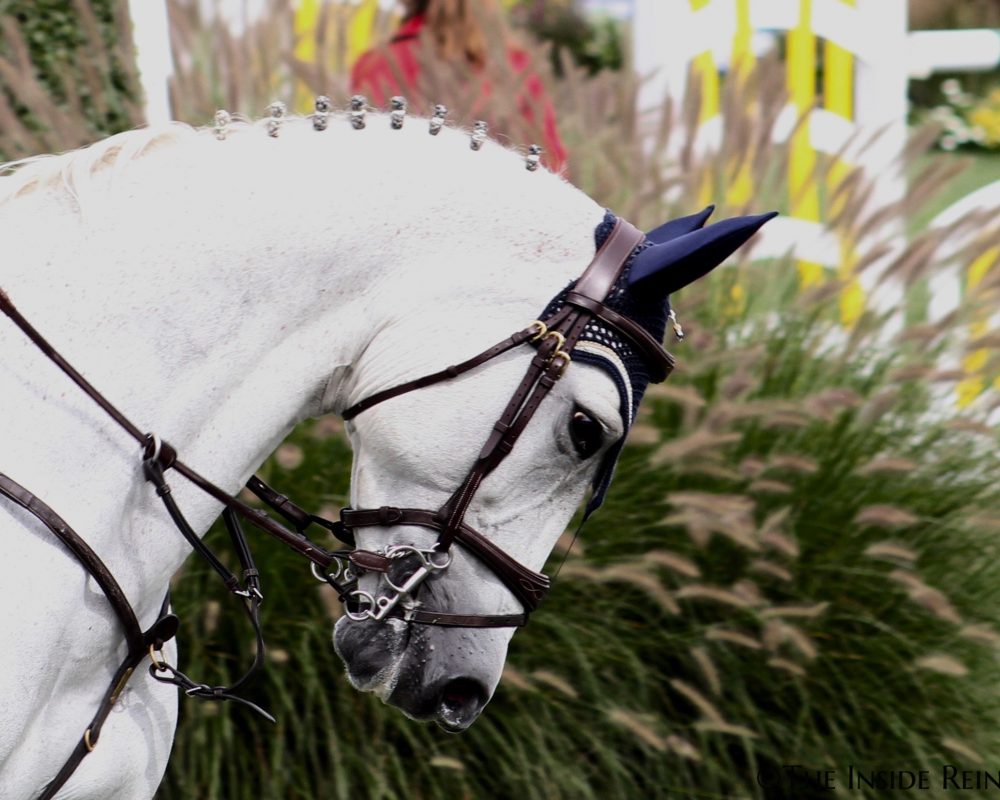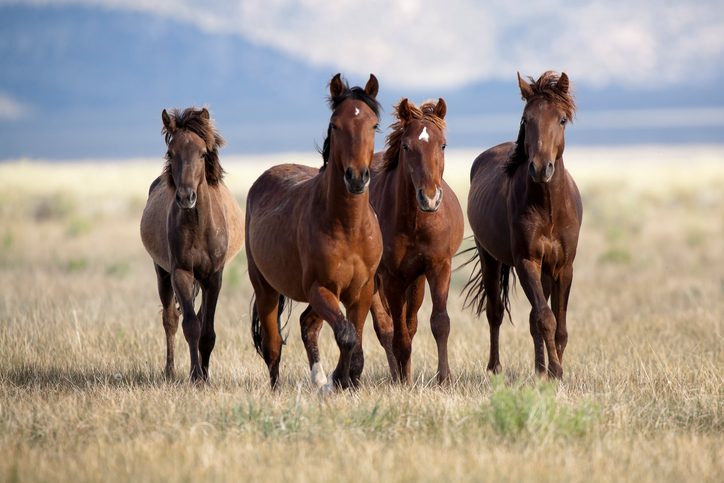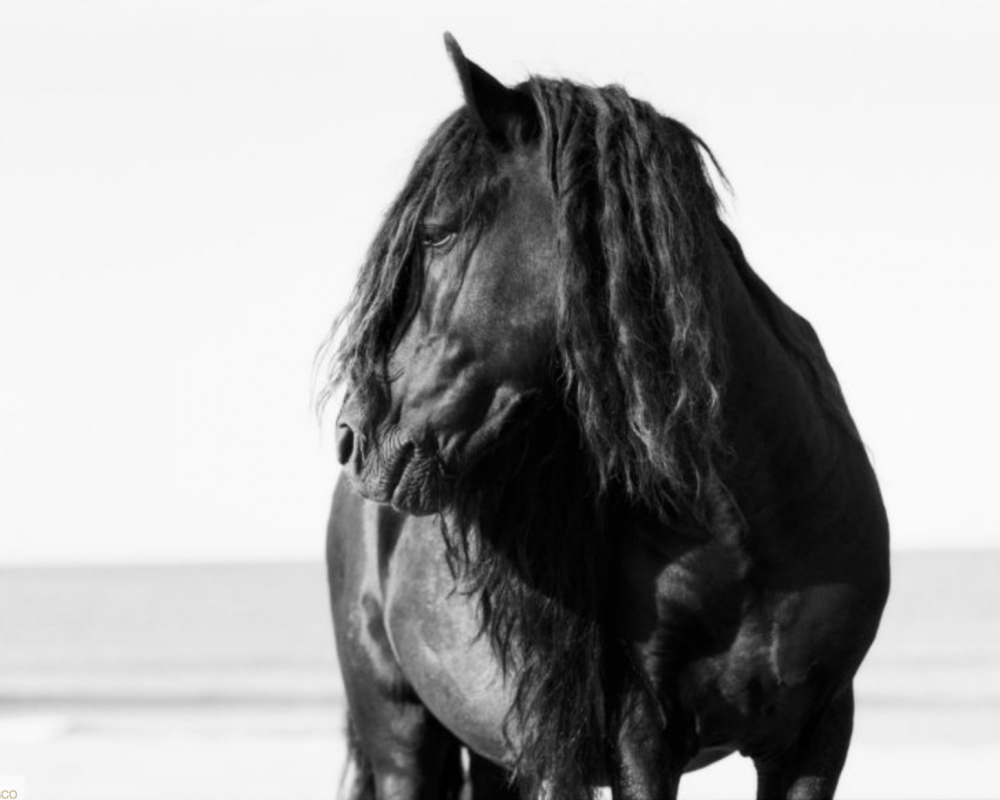For nearly a quarter century, Roberto Dutesco has given the world a window into the untouched beauty of Sable Island’s wild horses. His images capture the primeval essence of these animals, the prints evoking a primitive nature that lays dormant inside us all. What has resulted is a self-described “life project” and has evolved into Dutesco’s latest – and biggest – project, I Am Wild, launching later this year.
In the ‘80’s and ’90’s Roberto Dutesco made a name for himself in the fashion world, photographing major jean and lingerie campaigns during the golden era of the supermodel. Based in Montreal, Dutesco studied photography at the Dawson School, earning an assistant job with Canadian photographer Barry Harris.
Upon graduation, Dutesco took the bold step of opening his own studio, rather than taking an apprenticeship as his fellow graduates did. “I wanted to gain advantage by jumping ahead a few years,” Dutesco laughs. His initial projects involved tabletop photography, which quickly grew tedious. “I thought, what do I want to do next?” says Dutesco. “To travel. Where do I want to be when everyone is freezing in Canada? The Caribbean. Who’s there? It’s people that are shooting bathing suit, lingerie, or jean campaigns. That’s basically how it happened.”
The photographer steadily developed a name for himself; garnering international recognition with his racy shoots for the likes of Lee, Levis, and top lingerie brands. The peak of his fashion career came when he shot a series of campaigns with Gabriel Byrne for Stone Island (clothing which Dutesco insists he still wears on a daily basis). Sensing he’d reached the pinnacle of his fashion career, Dutesco considered his next step. At that time, famed fashion photographer Richard Avedon was reflecting on his career and expressed regret at having limited himself to fashion, echoing Dutesco’s sentiments. That was just the impetus Dutesco needed to make a change.
Enter Sable Island. Located 190 miles southeast of Halifax, Nova Scotia, the crescent shaped island is nestled in the Atlantic and is just 12.2 square miles in size. Aside from the famous horses, Sable is largely uninhabited, hosting rarely more than a few human residents at a time. Prior to Dutesco’s arrival, little had been documented about Sable. Aside from the now famous horses, the island boasts the dubious honor of being host to nearly 500 shipwrecks in its environs, the vessels having become encumbered on the island’s sandbars.
Dutesco first visited Sable in 1994. In his film, Chasing Wild Horses, which documents his time on the island, Dutesco says, “it wasn’t about the photographs so much as exploring my relationship with the horses.” In this case, Dutesco got more than he bargained for – exquisite photographs and the inspiration that would fuel the next 25 years of his work.
It’s Dutesco’s curious nature that drew him to Sable Island, a characteristic that stems from his upbringing in Romania, where he resided until relocating to Canada at 17. ‘I grew up in the countryside at my grandparents place,” says Dutesco, “it consisted of one road, two valleys, and a stream behind. At the end of the road was a dead end, which was a gigantic mountain. There was the sense that nothing could go wrong.” Dutesco says of his early childhood. “If you don’t have a fear in those environments you develop a larger sense of curiosity and a larger sense of exploration. Of course, as you grow up and explore you climb the mountain and go to a different valley and go further and further.” For Dutesco in the early ‘90’s, Sable was that different valley.
The Sable Horses made their pictorial debut in the mid ‘90’s. “Seeing the reaction to the Sable horses in those early photographs pushed me further into the exploration of Sable Island,” says Dutesco. During this time he still dabbled with fashion projects and that world subconsciously influenced his work with the horses. Like the Labrador current meeting the Gulf Stream at the tip of Sable Island, Dutesco’s world’s were also converging: fashion and horses. Early photographs held titles such as Love Bite, Linda, Christy, Naomi, and Close Up.
The horses became a priority for Dutesco as he made his transition from fashion photography to art. He set up shop in a friend’s showroom on Crosby Street in New York’s SoHo neighborhood; the Sable horses a far cry from the sportswear being sold in the same space. Dutesco began approaching art galleries with little success – the reaction of curators typically along the lines of “horses? Who wants horses?”
Fate stepped in. Dutesco arrived to lunch at Cipriani restaurant in SoHo with a box of prints in hand from an earlier meeting. A curious diner inquired about the photos and was instantly taken by the prints of Dutesco’s Sable Island horses. It just so happened that the curious diner was Peter Tunney. Tunney had previously been representing photographer Peter Beard and was looking for his next project. By the end of lunch, he’d found it.
Having been rejected by galleries in the past, the pair opened their own gallery on on Crosby Street. After six successful years on Crosby, Dutesco relocated to the current Grand Street location 5 years ago. “We kind of moved against the grain,” says Dutesco, “we were very quiet in the artistic world. We didn’t classify the work as art or decorative art or anything of the like, we just said ‘this is what it is.’” Dutesco’s gallery has thrived for 11 years in the posh neighborhood – the serene space and wild images a perfect juxtaposition to the melee of Manhattan. Though the art world was initially hesitant, circumstances have changed. “The success of the gallery is evident in its longevity and number of visitors. For some time now art dealers have taken notice. Many of their collectors are requesting our work so its kind of funny how things go,” says Dutesco.
Dutesco’s wild horses have seen more than SoHo. In the early years of his Sable Island photography, Dutesco was given access to the windows on the Sony building located at the corner of 57th Street and Madison Avenue. “All of the sudden I had windows to the world,” says Dutesco, “millions of people saw those images, they were there for a whole winter and into the spring.”
A member of the National Arts Club, having seen the Sony exhibition, invited Dutesco to have a show at their Gramercy Park location. “It’s the biggest show I’ve seen up until now. Gigantic images around 8 feet by 12 feet basically took over their space.” As a compliment to the horses, Dutesco compressed hundreds of hours of footage that he’d taken from his around the world travels into a 26-minute film that culminated with a poem by Dutesco titled A World Without Borders. “It was an expression of the idea that we are the same. You put the horses in that context and realize we’re not that different from the horses themselves,” says Dutesco. The show at the National Arts Club led to an installation at the United Nations where the horses developed a global following.
So what is it about these wild horses that draw such an audience? “I go back to who we are. We are wild,” says Dutesco, “The images reveal a sense of wilderness that we all have inside that’s been covered up. The actual connection is not necessarily the connection to the horse itself but the connection to what it is to be wild. It opens up the possibilities of who we are, why we are, and what is next. It’s that sense of wonder that horses have about them.”
Dutesco’s film Chasing Wild Horses had an impact on the Canadian government’s decision to declare Sable Island (which had previously come up for sale twice) a National Park Preserve, guaranteeing its preservation. “I will not take full credit for that, but I know I had a small influence in that decision,” says Dutesco.
Dutesco hopes that he can do for the American Mustang what he’s done for Sable Island’s equine population. “As far as I’m concerned, they’re national monuments. America was built on the back of the horse.” Dutesco references newspaper editor Horace Greeley’s expression, “Go west young man,” urging America’s westward expansion. “He didn’t say walk west, clearly he meant on the back of a horse,” says Dutesco. “I think what is happening in America [to the horses] is terrible and shameful. Perhaps I can bring some of the elements of [my work] with Sable Island into conservation efforts here in the U.S.”
Dutesco and his Sable Island horses have raised more than a million dollars for charities around the world and the photographer hopes to continue that trajectory. “A lot of people have benefitted from the wild horses,” says Dutesco. Dutesco worked closely with Petra Nemcova and her Happy Hearts Fund to open a kindergarten in Tsunami-struck Indonesia. The school opened its doors in 2008, murals of wild horses gracing the façade.
After nine years of development and a multi million-dollar investment, Dutesco and his team are launching his latest venture, I Am Wild, later this year. The project is meant to “create conversation, foster collaboration, and transform conservation.” I Am Wild is an interactive experience that pools together Dutesco’s more than 500 hours of Sable Island documentary footage into a virtual reality experience. The exhibition will launch on Malibu’s Zuma Beach and then travel the world, from New York to Dubai and everywhere in between. “I think you’re going to have an experience unlike any other, that you can’t have anywhere else,” says Dutesco. “I hope this project will shift mentality and remind everybody that we’re all wild and ultimately need to take care of everything, us included. We’re not taking care of the whales or tigers and we’re not taking care of our own selves.” I Am Wild gives 25% of all proceeds to conservation efforts and charities.
Dutesco’s work is a call to action. “On a global scale, the wild horses and wilderness can help one another – but this cannot happen without your [the public’s] help, your kindness and generosity; it cannot happen without your love,” says Dutesco, adding, “please help, give, make, have in memory, in celebration of what it is to be truly wild, knowing that deep down, beneath the layers of civilization, man is also wild.”
By Ashley Fairfield-Remeza



August 11, 2017 at 7:39 pm
Roberto
Lead the way to I Am Wild being what you envision.
With global appreciation
Robert Shereck
September 9, 2017 at 3:07 pm
I am So proud of you, there is no stopping you in your notable accomplishments!
September 10, 2017 at 5:12 pm
Roberto
For years I’ve been wanting to thank you but not knowing how. I never knew of your work and one summer evening 3 or 4 years ago I passed your Crosby Street exhibit and had to go in. Those huge photos pulled me. You were closing up but didn’t seem to mind my presence and you didn’t rush me. It was months later when I finally watched the CD you handed me as I was leaving that you where you, the wild horse artist. I watch your video often and everyone I share it with feels as mesmerized as I do.
Linda from Brooklyn